North East Syria Is Still Dealing With the World’s Forgotten ISIS Problem
It’s been four years since Kurdish-led forces defeated the ISIS caliphate. But still today, the new authorities in North East Syria have to deal with thousands of foreign ISIS fighters, whose homelands refuse pleas to take them back.

Women with their children walking in the al-Roj camp in North East Syria, which, along with the al-Hol camp, houses thousands of die-hard foreign ISIS women. (Anna Rebrii and Liza Shishko)
“I never liked it here in Syria,” laments Ali, a sixteen-year-old Turkish American. He hails from New York, yet we meet him at a rehabilitation center for the so-called lion cubs of the caliphate, boys whom ISIS once trained and sent to kill. He is in the middle of giving a haircut to one of his friends, dutifully sitting in front of a mirror, as part of the barber class that the former child fighters are given by the Autonomous Administration of North and East Syria (AANES).
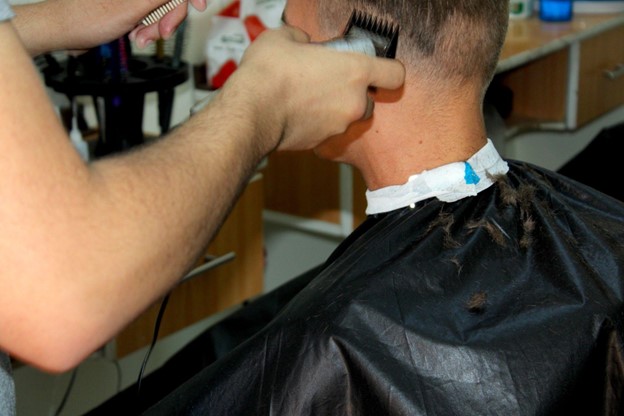
“I came here when I was in the fourth grade,” he tells us hastily, visibly excited to meet someone from his hometown. “I really want to go back to New York and catch up with my studies.” We watch the razor moving swiftly in his hand. “At least I’ll know how to do a haircut when I leave here.”
Ali — like the other inmates mentioned here, he is cited under a pseudonym — is one of around a hundred adolescents hailing from all over the world whom we find attending lessons in the al-Houri center near Qamishli, in North East Syria. Ranging from twelve to twenty-two years old, some of the boys are intently bending over a Singer sewing machine, while others sit around a female teacher giving a literacy class. A French boy is playing Beethoven’s “Für Elise” on an electric piano, while his classmate from Pakistan is practicing guitar — activities that were once forbidden to them under the caliphate’s rule.
A spacious, red-bricked courtyard with a fountain in the middle might briefly conceal what kind of place this is. Yet, the razor wire on the surrounding walls serves as an ever-present reminder that these boys are not free to exit the gate.
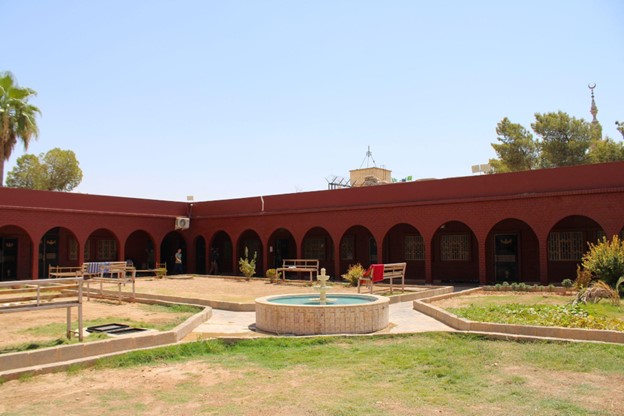
Deradicalizing the Lion Cubs
As Ahmed Lawend, a member of the center’s administration, told us, there is no one here who had not been initiated in one way or another into the ISIS fighting force. “Some worked as ISIS police, others joined the frontlines, yet others were trained to plant mines.” Some were brought to the center with battle wounds from ISIS’s last bastion in Baghouz.
Lawend was quick to add that this was not a prison. “These kids bear no guilt. Many were told by their families they were coming here as tourists.”
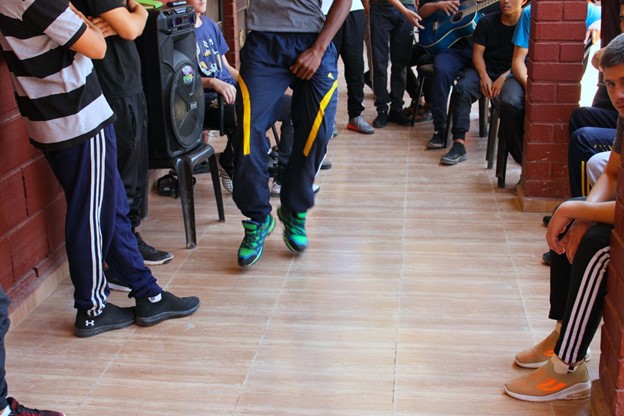
His and his colleagues’ job at the al-Houri center is to eradicate the ISIS mentality that most of these boys were unwillingly exposed to — both before the caliphate’s defeat and afterward, when they had stayed in ISIS camps or prisons.
“My father brought me here,” said Mohammed, a tall nineteen-year-old from Trinidad and Tobago, after we watched him break-dance to a rhythmic tune blasted from a loudspeaker. Like all the boys we talked to, coming to Syria was not the future Mohammed would have decided for himself. Most were too young to make that choice.
With his father killed and his older brother imprisoned, Mohammed yearns to regain contact with his mother who stayed behind, across the oceans. When asked for her name he stumbled, then — with a rueful smile and his face beading with sweat — told us that he had “forgotten [his] mother’s last name.” It has been a decade since he has heard a word from her.
Foreign ISIS Fighters, Forgotten by the World
Mohammed wants to be a dancer or a singer when he is back in the Caribbean. Yet, it is unclear if any of the boys will ever be able to use the knowledge and skills they are developing in the center. While most of the Syrian teenagers, also housed here, have already been convicted by AANES courts for local ISIS affiliates and subsequently returned to their families, the foreigners’ prospects of going home are bleak: their countries of origin have expressed little interest in welcoming them back.
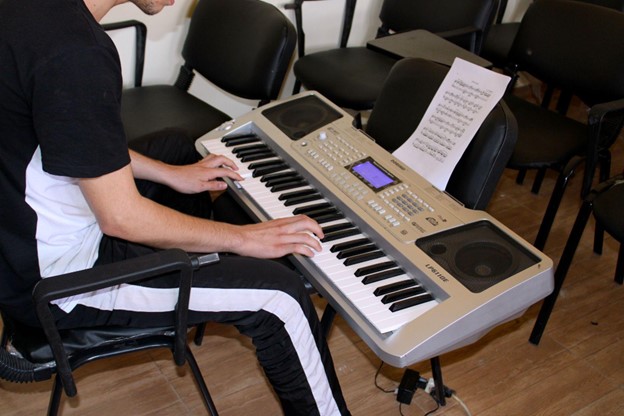
As a recent report by the Kurdish Peace Institute (KPI) documents, just 4 percent of an estimated two thousand foreign ISIS fighters held in the AANES-run prisons have been repatriated by their home countries since 2019, when the ISIS caliphate was dealt the final blow by the Kurdish-led Syrian Democratic Forces (SDF). The so-called developed countries of the West have been the most reluctant to take back the men whose sympathy for ISIS first came to life within those nations’ borders. As Matt Broomfield writes in the KPI report, “States like France, Germany, Canada, Australia, Belgium, and the UK have all failed to repatriate a single male fighter.”
An additional 12,500 wives and children of foreign fighters are languishing in underfunded camps. With only a trickle having been repatriated so far, the AANES finds itself unfairly burdened by the world’s jihadism problem.
For years, the administration has called on the international community to either repatriate their nationals or to come and try them on the land where they committed their egregious crimes. Governing a war-torn region under a de facto embargo by Turkey and the Assad government, with no international recognition, the AANES simply lacks the resources to indefinitely guard and care for thousands of these extremists. With its pleas for help unanswered, it has recently announced that it will try the foreign fighters on its own, hoping to finally prompt action from an indifferent international community.
A Ticking Time Bomb
This is not merely a question of justice, but rather of the threat that ISIS continues to pose to the world. The boys we met did not join ISIS of their own volition — but many individuals currently held in AANES prisons and camps did. As Bedran Çiya Kurd, cochair of AANES’s Department for External Affairs, made clear in a press conference regarding the upcoming trials, ISIS’s repeated breakout attempts are proof enough that its members have not given up on their genocidal mission.
When last year ISIS used two suicide truck bombs to blast a hole in the wall of a prison in Hasakah, it took the SDF and its US and UK allies ten days to quell the insurgency. Some ISIS militants had taken the prison staff hostage, while others from ISIS sleeper cells entered civilian homes. By the end of the fierce battle, 117 military and prison personnel were murdered, in addition to 374 ISIS members killed.
According to SDF fighter Ararat Azad (a pseudonym), who participated in the suppression of the attack, ISIS’s brutal ways have remained unchanged: “When we arrived to liberate the residents in whose houses ISIS militants were barricaded, we saw the same thing as during the liberation battles of Kobani, Raqqa, or Deir ez-Zor [before the ISIS territorial defeat in 2019]. In one of the houses in Hasakah, we found five severed heads of its residents, lying in the yard.”
So, ISIS still poses an ongoing threat. Yet the very same international powers that joined the US-led International Coalition Against ISIS, who rushed their ground and air forces to recapture the jailbreakers, have done little to propose a long-term solution for the thousands of prisoners who wait for another fateful chance of escape.
Breeding Ground
While undeniably important, the trials of former ISIS fighters are not enough to fully address the ticking time bomb that the AANES now has to handle, with insufficient external support.
As has been widely documented, a new generation of ISIS is being brought up in the notorious al-Hol and al-Roj camps that house thousands of die-hard foreign ISIS women. These women have taken it upon themselves to reproduce ISIS manpower by indoctrinating and training their children as future ISIS fighters. Perhaps even more disturbingly, they are forcing adolescent boys to impregnate the camps’ female inmates to increase the number of child soldiers.
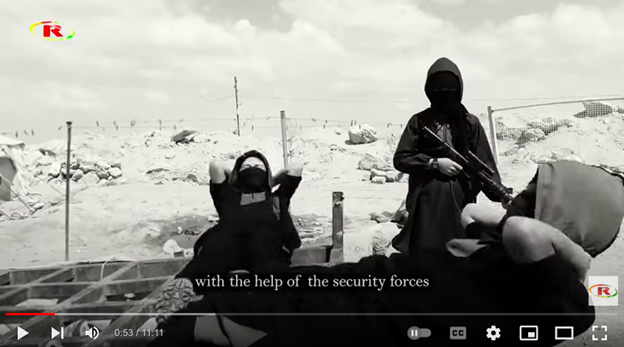
With roughly five thousand children already living in the foreign section of al-Hol, their number has been growing at an alarming rate: the camp administration’s estimates that an average of sixty-six babies were born per month in 2021 alone.
It is for these reasons, Lawend told us, that the administration chooses to transfer teenage boys to the rehabilitation centers until they reach adulthood. While a recent UN report accuses the AANES of arbitrarily separating children from their mothers, the administration insists that it has no other choice given the latter’s unrelenting dedication to ISIS. It is clear that while it has lost its own territory, ISIS’s reign continues within these camps: guards have been stabbed, schools set on fire, and women who refuse to cover their heads are punished with death.
At the al-Roj camp, which is known to be the less radical and dangerous of the two, we are met with children of all ages running around the sprawling rows of tents. Seeing us strangers on their territory, they begin to play war games, holding their fingers in the shape of guns, aiming directly at our heads. A five-year-old swears at us in Turkish. This is a seemingly mild welcome: at the al-Hol camp, guests are often targets of thrown stones.

“They’re just playing,” says Margarita, one of the camp’s inmates. She is from Moldova; her husband is in the Hasakah prison where last year’s outbreak took place. Her son, who is with her in the camp, will soon turn fourteen — the age that boys are usually taken to the rehabilitation centers. Some of the children return to camp every month for a week, we were told by the guard Leila (a pseudonym), who accompanied us for security reasons: “During this week, the children change a lot and forget everything they were taught.” While less violent than the al-Hol camp, the al-Roj camp is also home to unapologetic ISIS supporters.
“We hope very much that we will leave before our son is taken to this school. We heard that children are not allowed to play sports there. They are treated cruelly,” says Margarita, repeating the false claims of mistreatment spread by ISIS women on social media, where they openly express their hopes to bring up their sons as fighters and fundraise to escape from detention.
“Of course, we would most like to go to Turkey,” Margarita adds dreamily, when asked what kind of future she wants for her family. “There we would be free, we could live as we want. Practice our religion freely. For us, the best option is if Turkey liberates our camp like the camp in Ayn Issa.”
A NATO Member Fuels ISIS’s Resurgence
Margarita’s hopes are not too far-fetched. Over the years, Turkey has proven to be ISIS’s most reliable ally. More than eight hundred women and children linked to the Islamic State escaped from the Ayn Issa camp when Turkey shelled the area during its 2019 invasion of North East Syria. Similarly, as part of its large-scale 2022 aerial offensive on the region, Turkish air forces targeted the al-Hol security guards, allowing some detainees to escape. During last year’s Hasakah prison outbreak, Turkey launched several airstrikes on the area nearby, with one drone attack hitting an SDF vehicle on its way to recapture insurgents.
Against this background, the SDF’s claim that last year’s outbreak was planned inside Turkey and the areas of Syria under its control is highly credible. The so-called safe zone — a euphemism for Turkey’s internationally sanctioned occupation of northern Syria — has been safe for only ISIS members and their likes.
It is in this “safe zone,” Azad told us, that the escaped ISIS militants seek refuge. So do the ISIS women who are regularly smuggled out of the camps. Some reportedly cross into Turkey, where ISIS continues its operations. As we learned from Margarita, who had the TV in her tent set to a Turkish cartoon, the al-Roj inmates teach their children Turkish — another clear indication that Turkey has gained a reputation as a safe haven for those with links to ISIS.
What’s Next?
Back at the Al-Houri center, Lawend is convinced that the boys are better off away from their mothers. But without repatriations, the center faces a dead end. “How can we send the poor things back to the camps or prisons when they grow up?” Despite the Autonomous Administration’s best intentions, the real solution can only come with the political and material backing from the international community. In the meantime, as Turkey continues to attack the region, targeting the very same people tasked with guarding tens of thousands ISIS suspects and supporters, the world chooses to turn a blind eye to the very real danger of ISIS 2.0.
This post was originally published on this site be sure to check out more of their content.






